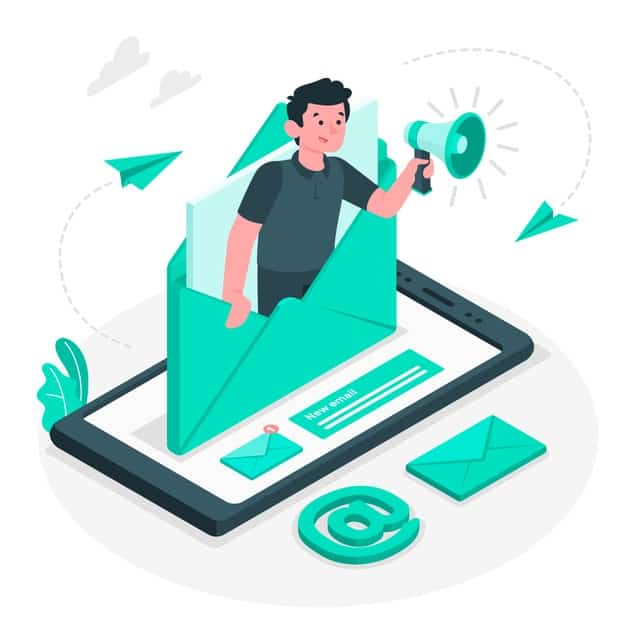This is a quick guide on Email Marketing for Beginners or for anyone who has heard about email marketing and isn’t sure if it is something you should be doing for your online business.
If you are a novice in email marketing or don’t know a thing about it, don’t let it worry you. This is something that confused me for years. My skills lie in content creation, coding, and breaking down information into bite-size chunks. But after picking up on a few of the basics I have made it work for me. I’m hoping blog post is to take away some of the mysteries of email marketing for beginners or a refresher for all others.
Table of Contents
What is email marketing?
Email marketing is a way to communicate with customers directly via email. It is the process of sending people information emails to advertise your product or help build up a customer relationship.
Most of us have signed up for a free item online and have started to receive emails from that website. Sometimes these are helpful or informative emails, and those that are not engaging will soon find us hitting the unsubscribe button.
Getting Started with Email Marketing for Beginners
To get started, you’ll need an email provider. Don’t try to send out emails with your personal email address. This is difficult to manage and will probably have all your messages winding up in the spam folder.
What are the steps?
Here are the 4 basic steps for email marketing for beginners. Don’t worry if you don’t know all the terms yet. We will go over it in detail.
- Create a lead magnet
- Use that magnet to collect Emails
- Create content that your subscribers would like
- Engage your customers with that content.
Email Lists
What is an email list?
An email list is a list of subscribers to your email newsletter. Individuals are free to sign up or unsubscribe at will. You can also manually add or delete contacts from the list as well.
Inbound vs outbound email marketing
In a nutshell, inbound emails are when you build up a list by customers signing up on your website and handing over their email, often in exchange for something.
Outbound emails are from a purchased list from a third party. For the rest of the post, I will only be focusing on inbound marketing.
Lead Magnets
What is a lead magnet?
A lead magnet is something given away in order to obtain a customer’s email address. This is usually a digital product. When it comes to email marketing for beginners this is a step often overlooked. I’ve seen many shops simply offer discounts as the first interaction with a customer. While this can be effective, an actual product like the ones on the list below can help build up a better customer relationship.
Example of lead magnets
- Checklists
- E-Books
- Cheatsheets
- Product Samples
- Online courses
- Templates
- Coupons
- Memberships
| Products | Example Lead Magnet |
|---|---|
| Women’s Fashion | Guide to Winter Accessories |
| Beauty Products or Makeup | Natural Face Makeup chart |
| Nutritional or Cooking Products | 5 – day meal plan |
| Travel Accessories | List of the secret gems in Bangkok |
| Garden Supplies | Growing Guide for Succulents |
List Building
Building your list is a crucial step in email marketing for beginners. If you don’t have anyone to send emails to, you can’t market to them.
What is list building?
List building is the act of collecting emails and growing your list. It is not enough to get sign-ups. You have to keep the subscribers interested by nurturing the list.
What is list nurturing?
List nurturing is the act of offering stimulating or useful subject matter to let subscribers get to know you and your brand or website and to learn about you.
You should email the list on a regular basis otherwise the list will grow cold, and when you finally do send an email, the subscribers will most likely forget who you are or why you are emailing them. This is a mistake I made and it can be tough to get the list warmed back up.
How do I build up an email list?
- Develop a lead magnet that solves a problem for your customers.
- Set up a landing page.
- Make a welcome email.
- Set up a nurturing campaign (see below).
This is one of the most important parts of email marketing for beginners to take away.
What is a landing page?
A landing page is a page on your site that is designed to convert visitors into leads by signing up to your list. Landing pages are custom-built to a particular campaign or offer and steer visitors towards a single call to action.
It is typical to have a different landing page for each offer so that customers can be guided through a predestined series of emails.
Email Content
You’ll need to have something to send in your messages. If you can help your customers by offering consistent content relative to your product, you can run a successful strategy. The basic idea is to be helpful and occasionally offer promotions.
Email Content Examples
| Product | Content |
|---|---|
| Women’s Fashion | Fashion tips, What’s hot, Trends |
| Beauty Products or Makeup | Makeup tips, Beauty regimes |
| Nutritional or Cooking Products | Recipes, Cooking techniques |
| Travel Accessories | Travel adventure stories, Travel Tips |
| Garden Supplies | Gardening Tips, Seasonal Guides |
Campaigns
What is an email campaign?
An email marketing campaign is a series of individual email messages. They may tell a story, point out problems and solutions, or ask the subscriber questions. Email marketing campaigns are used for advertising or promoting a product or nurturing customers to and in time will lead to an offer.
What are some types of campaigns?
- Nurturing Emails
- Affiliate Promotion
- Cart Abandonment
- Re-Engagement
- Discount Offers
- Product Launch
Automation
What is email automation?
Email automation is being able to send time or action-triggered emails based on logic or the subscriber’s actions.
How do I set up automation?
This is usually different for each email provider, but they will have an easy-to-use interface to walk you through it. The most typical animation is to send emails at time intervals. Most providers, such as MailChimp, have automation as a paid feature.
Is Email Marketing right for me?
If you have a message to send or a product to sell, email marketing can be quite effective. The best strategies seem to be a combination of helpful and friendly emails mixed with occasional offers.
If you are only going to use it to send offers on your product, it is going to be an uphill battle.
In my opinion this is not worth your time if:
- You are expecting instant results
- There is no plan to nurture your list
- You don’t have anything to share with your customers
Email Marketing Terms
Here are some email marketing for beginners terms you’ll want to know.
Newsletter
Information on a particular subject is sent on a regular basis to the members who have chosen to receive it.
List segmentation
The breaking down of your email list in smaller sub-lists or segments. This may be categorized, for example, by customers who have purchased before, or live in a certain location.
Bounce Rate
This is the percentage of sent emails that don’t make it to the inbox of the subscriber.
Open Rate
This is the percentage of sent email that were opened. If you have a low open rate, you will want to adjust the subject line of your emails.
Click Rate
The percentage of people who clicked on the link. If this rate is low, but you have a good open rate then you need to adjust your offer or text inside your email.
Opt-Out
This is when a subscriber leaves your email list. You will need to have a link in your email for customers to click on to unsubscribe. Most email marking providers include this for you.
Email Funnel
An email funnel is a graphical representation of how a visitor becomes a subscriber and then turns into a customer. Because some people will always drop off at some stage, the numbers always get smaller.
Conclusion
I hope this email marketing for beginners guide helps you understand more of the basics and answers some questions. This is only intended as a starting point. If you want to learn a lot about this subject in-depth, I recommend following the blog of Meera Kothand, who has been instrumental in my study of the subject.


